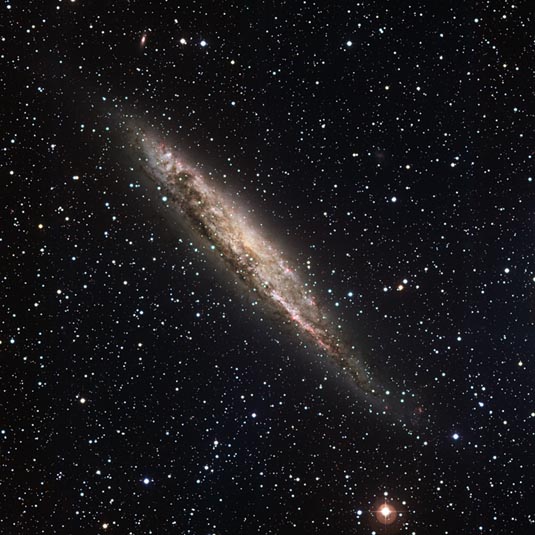
Spiral Galaxy
RA 13h 5m 27.33s Dec -49° 28' 3.76"
Centaurus
12 million light years
21.96 x 21.96 arcminutes
North is 0.0° left of vertical
ESO
September 2, 2009
Related images: G0931 G9922a G9922b G1007 G1310
ABOUT THIS IMAGE:
ESO has released a striking new image of a nearby galaxy that many astronomers think closely resembles our own Milky Way. Though the galaxy is seen edge-on, observations of NGC 4945 suggest that this hive of stars is a spiral galaxy much like our own, with swirling, luminous arms and a bar-shaped central region. These resemblances aside, NGC 4945 has a brighter center that likely harbors a super-massive black hole, which is devouring reams of matter and blasting energy out into space.
As NGC 4945 is only about 13 million light-years away in the constellation of Centaurus (the Centaur), a modest telescope is sufficient for skygazers to spot this remarkable galaxy. NGC 4945's designation comes from its entry number in the New General Catalogue compiled by the Danish-Irish astronomer John Louis Emil Dreyer in the 1880s. James Dunlop, a Scottish astronomer, is credited with originally discovering NGC 4945 in 1826 from Australia.
Today's new portrait of NGC 4945 comes courtesy of the Wide Field Imager (WFI) instrument at the 2.2-meter MPG/ESO telescope at the La Silla Observatory in Chile. NGC 4945 appears cigar-shaped from our perspective on Earth, but the galaxy is actually a disc many times wider than it is thick, with bands of stars and glowing gas spiraling around its center. With the use of special optical filters to isolate the color of light emitted by heated gases such as hydrogen, the image displays sharp contrasts in NGC 4945 that indicate areas of star formation.
Other
observations have revealed that NGC 4945 has an active galactic nucleus,
meaning its central bulge emits far more energy than calmer galaxies like
the Milky Way. Scientists classify NGC 4945 as a Seyfert galaxy after
the American astronomer Carl K. Seyfert, who wrote a study in 1943 describing
the odd light signatures emanating from some galactic cores. Since then,
astronomers have come to suspect that super-massive black holes cause
the turmoil in the center of Seyfert galaxies. Black holes gravitationally
draw gas and dust into them, accelerating and heating this attracted matter
until it emits high-energy radiation, including X-rays and ultraviolet
light. Most large, spiral galaxies, including the Milky Way, host a black
hole in their centers, though many of these dark monsters no longer actively
"feed" at this stage in galactic development.